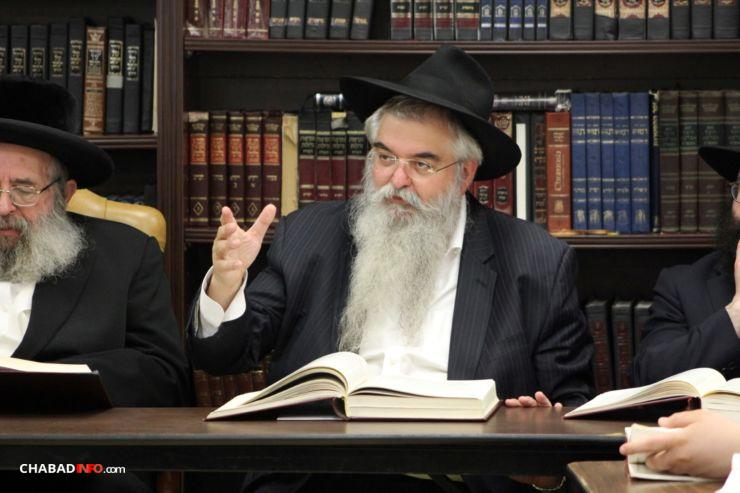Rabbi Zushe Wilhelm: “He Established Many Pupils”
From Beis Moshiach Magazine: Rabbi Zushe Wilhelm was a man of many hats. In his 62 years, he managed to revolutionize the lives of Jews in Caracas as a bochur; lead the Jewish community of Panama as a newlywed man; raise generations of talmidim in his 32 years at the helm of Mesivta Oholei Torah, bring the Rebbe’s teachings to vast crowds and most recently — lead “Lemaan Yilmedu” • Presented in honor of his second yahrzeit on Daled Shevat • Full Article
By Avrohom Rainitz, Beis Moshiach
There are Chassidim who teach Chassidus; Chassidim who passionately delve into sugyos in Shas; there are those who engage in the study of halacha and others who are involved with drush. Some Chassidim draw the hearts of Jews to their Father in heaven and there are some who bring the wellsprings of Chassidus to other frum groups. There was a Chassid, one person, who was involved in all of these areas very successfully. This was Rabbi Yeshaya Zushe Wilhelm a’h.
It is hard to categorize someone as multifaceted as R’ Zushe, as he was known. The one common thread that runs through everything that he was involved with over the years – he established many talmidim, hundreds, thousands, who will remember him forever as someone who left an imprint deep within their hearts and minds.
A BACHUR CORRESPONDING WITH RABBANIM
R’ Zushe was born in Crown Heights on 18 Elul 5719. He was named Yeshaya Zushe for his grandfather, the Boider Rav, rav of the town of Boida and then rav of Moscow under the communists. It would later become apparent that having been born on the birthday of the Alter Rebbe, author of the Tanya and the Shulchan Aruch, had an impact on his life and activities. R’ Zushe had a koch in halacha, in general, and in the Shulchan Aruch HaRav in particular, as well as spreading Chassidus.
R’ Zushe attended yeshivas Oholei Torah and through his childhood and young adulthood he was zoche to be near Beis Chayeinu.
In 5737, Rabbi Moshe Perman, shliach in Venezuela, started a new yeshiva in Caracas. After a group of balabatim from Caracas went to the Rebbe and presented the idea, R’ Zushe Wilhelm was one of the ten bachurim chosen for the mission. Rabbi Zushe Winner was sent with them to serve as rosh yeshiva. On Shabbos, parshas Eikev 5737, after shacharis, the Rebbe announced that there would be a farbrengen and at the end of the farbrengen, he gave mashke to the talmidim-shluchim and blessed them, “A good trip and it should be with great success and spreading the wellsprings throughout the country and around it.”



Three weeks later, on motzoei Shabbos Ki Seitzei, a few days before going on shlichus, the talmidim stood in gan eden ha’tachton near the Rebbe’s room. Before the Rebbe entered his room, he said to the secretary, Rabbi Binyamin Klein that they should be present at kiddush levana.
A few minutes later, the Rebbe went out for kiddush levana and before beginning the bracha, he asked whether the shluchim to Caracas were there. It was only after they approached that the Rebbe began to say the nusach of kiddush levana. (The Rebbe said “shalom aleichem” to two of the talmidim, R’ Shneur Zalman Baumgarten and R’ Mendel Dubrawsky.) After kiddush levana, the Rebbe said, “A gut voch, a gut chodesh” to all and to the talmidim-shluchim he added, “May it be a proper trip and with success!”
One of the members of the group, R’ Shneur Zalman Baumgarten, said that when they arrived in Venezuela, the place was spiritually desolate. Religious Jews who had moved there went off the derech a few months after arriving. When the bachurim arrived, the local Jews laughed at them and said, let’s see you in six months; you will have taken off your yarmulkas and tzitzis.
Of course, with the koach of the Rebbe, the bachurim accomplished a great deal. They started a learning program for children and within a short time, 70 children were attending. They organized a camp for children and when the children returned home they demanded that their parents eat kosher and keep Shabbos.
The talmidim-shluchim published an anthology of chiddushei Torah and one already saw R’ Zushe’s koch in the teachings of the Rebbeim in particular when he edited together with R’ Menachem Mendel Gordon an index to the chiddushim of the Tzemach Tzedek on mesechtos in Shas. While in Caracas, R’ Zushe began to correspond with rabbanim around the world. In the sefer of responsa of the gaon, Rabbi Avrohom Yaffe Shlesinger, Beer Sarim, there is a teshuva that he wrote to “someone I don’t know but from between the walls of his letter it is apparent that we are dealing with a tzurva d’Rabbanan (a budding Torah scholar)… R’ Yeshaya Zushe Wilhelm in the capital city of Caracas, Venezuela.” Similarly, in the sefer Mishneh Halachos there is the teshuva from the gaon, Rabbi Menashe Klein. R’ Klein prefaces his response with an apology for not addressing him with the proper titles, “because I don’t know what to call him, rav or rosh yeshiva …” From the wording one sees how these rabbanim were amazed by what R’ Zushe wrote and they did not consider that the writer was a yeshiva bachur, moreover, one who divided his time between learning and spreading the wellsprings.
Aside from his love of studying sefarim, R’ Zushe also took an interest in the background of every sefer and the history of the author. When he paid a shiva call at the home of a mekurav whose grandfather died, he noticed a set of Meam Loez that was a first edition and written in Ladino. A month ago, when he farbrenged with talmidim of Oholei Torah for Hei Teves, he said that when he saw this rare set, he immediately called the Rebbe’s library to find out whether it had these sefarim. When he was told no, he spoke with the family and received four thick volumes (in the format of Likkutei Torah) on four of the five books of the Torah. The Rebbe responded with “teshuos chein” and asked whether they could bring the fifth volume.
R’ Zushe’s love for sefarim continued when he returned from shlichus in Venezuela, two and a half years later. He was put in charge of the Otzar HaSefarim on the side of the small zal of 770. He put a lot of work into expanding the library and before he married, Rashag gave him a certificate of appreciation for this work.
As with everything he did in his life, he put all his energy into it. He sent letters and sefarim to rabbanim, asking them to send their sefarim to 770. When the sefer Chiddushim u’Biurim b’Shas from the Rebbe was published, he and his friends decided to send it to great rabbanim. They began raising money for the project and wrote about it to the Rebbe.
The Rebbe answered, “This is not the way at all – as opposed to authors who need parnassa gashmis and when it is not possible in more dignified fashion they do like the above-mentioned and this is simple to understand. The paved path – that the talmidim should koch in learning (they included) and meet with the above-mentioned and talk to them in learning in proper fashion and mention the sefarim, and this is obvious.” Obviously, R’ Wilhelm and his friends did just that and, in this way, brought the Rebbe’s teachings to a number of great rabbanim.
SHLICHUS TO PANAMA
R’ Wilhelm married Esther Sperlin on 23 Sivan 5742. His son, R’ Chaim Yisrael, related that R’ Chodakov went to the kollel and urged the yungeleit to author Torah publications. Following this, R’ Zushe began writing a wide-ranging Torah composition called Ziv Ha’Sheimos with all the laws and customs pertaining to people’s names. After learning in kollel, R’ Zushe began working as a maggid shiur in yeshivas Oholei Torah.
In 5746, the Ashkenazic community in Panama, Beit E-l sent a request to 770 saying they were looking for a new rav. R’ Chodakov asked R’ Zushe, who knew Spanish, and suggested that he take the position. R’ Chodakov made it clear that if he went, it wouldn’t be only as a rav of a community but also as an independent shliach. He would have to do programs independent of and beyond the parameters of the shul. Indeed, immediately upon arriving there, R’ Wilhelm set up a Gan Yisrael camp which was attended by many children in the community.
R’ Wilhelm spent three successful years with the Jewish community of Panama until the outbreak of civil war in the spring of 5748. After a military overthrow, America began sending in large numbers of military forces to its bases in the area of the Canal.
By instruction of the Rebbe, R’ Wilhelm sent his family out. He was told to remain as long as the Jewish community continued to live there. As an American citizen on the one hand, a resident of Panama on the other hand, he had to contend with a complicated situation. For example, the Panamanian government contacted him and offered him a security team from the Panamanian army. The Americans also contacted him, wanting to send him a security detail from the American army. He was very worried that if he accepted the offer of either of them, the other side would turn him into an enemy and a legitimate target. In the end, he was able to avoid both of them.
Several tense and scary weeks went by. Throughout this time, R’ Wilhelm continued to encourage the Jews who remained in Panama. One of his friends, who owned a private plane, promised that when he left the country, he would take R’ Wilhelm. However, when the time came, the friend fled and did not call the rav.
That Thursday, the electrical grid in the country collapsed and then all lines of communication were cut off. R’ Wilhelm realized he had to escape before it would be too late and he hurried for the airport. At the terminal he met the last Jews who hadn’t yet left. One of them emotionally said to him, “Rabino, this is literally the Exodus from Egypt …”
It was first Friday morning that they announced that one plane would be leaving for the United States, precise destination unknown. They all wanted to board that plane. Miraculously, R’ Wilhelm was able to board the plane and only after take-off were they told that they were headed for Puerto Rico. R’ Wilhelm was able to take a flight from there to Miami and a few hours before Shabbos he arrived safely at relatives in Miami.



MENAHEL AND MECHANECH
Upon returning to New York, a new, long chapter in his life began. He returned to working as a maggid shiur in Oholei Torah’s mesivta. Half a year later, he was appointed menahel, a job he worked at until 5779.
Half a year after R’ Wilhelm began working as a menahel, Rabbi Nachman Yosef Twersky wrote a letter to the Rebbe. Among other things, he wrote of the success of the new menahel. The Rebbe circled these lines and wrote, “Teshuos chein, teshuos chein for the aforementioned. I’ll mention it at the tziyun.”
In a conversation with R’ Twersky, who worked with R’ Wilhelm for over 30 years, he said that in R’ Wilhelm’s job as a menahel he combined opposite traits. On the one hand, he was a strong menahel who knew how to demand that the melamdim do their job without any exemptions. On the other hand, he was so good to the melamdim that all of them felt like one family with him. “He invited us to his simchas as though we were part of his family.
“He was the same with the talmidim. On the one hand, he ran the yeshiva firmly; on the other hand, he loved the talmidim and the talmidim loved him. He would never consider rejecting weak students. He accepted everyone and put in a lot of effort to advance the weak ones.
“Even after talmidim graduated, he kept in touch with them. In the days before whatsapp, he wrote post cards.”
His children say that two weeks before his passing, one of his students came to visit. He had been a problem student whom R’ Wilhelm was mekarev despite everything. During the visit, the former talmid asked: I was a troublemaker. Why did you continue to remain in touch with me over the years?
R’ Wilhelm said with a smile: In Russia they said that if one wheel makes squeaky noises, you need to grease it. It was because you made “noise” that I felt the need to be mekarev you!
One of the teachers said that now and then, R’ Wilhelm would ask him whether there was anyone in his class who needed material assistance. Upon being given the information, R’ Wilhelm would go to that talmid and say that because of his diligence in learning, the yeshiva wanted to give him a special grant. He did this in such a dignified way and he dressed that talmid from head to toe with a hat, suit, shirts, pants and shoes. He paid hundreds of dollars and it was done in such a way that the talmid did not realize he was receiving tzedaka.



YESH LITMO’AH AND SHE’EILOS L’CHAZARA
R’ Wilhelm was a broad thinker. When he learned a particular subject, he researched it from top to bottom. He sought to convey a love for Torah knowledge to his students and he was always thinking of how to get the students interested and create an atmosphere of enjoyment of Torah study. He began producing a booklet he called, Yesh Litmo’ah with fascinating Torah questions.
A shliach in Eretz Yisrael who learned in the mesivta said that he was once at a lecture in the Great Synagogue in Yerushalayim and one of the rabbanim asked those present all sorts of questions. With one of the questions, none of the 200 people present knew the answer. He was the only one who knew it because the question had appeared in one of the Yesh Litmo’ah booklets. He didn’t want to stand out and so he whispered the answer to the rav sitting next to him. That rav got up and said: The Chabadnik next to me is the only one who knows the answer, so he had no choice and he got up and said the answer. This made a kiddush sheim Lubavitch.
Since, in the Shulchan Aruch HaRav, one se’if sometimes has ten details and in the course of regular learning people sometimes don’t pay attention to all the details, R’ Wilhelm wrote up “Questions for Review,” in which he broke down the halacha into individual points, so that when reviewing with his questions one notices all the details in the golden wording of the Alter Rebbe. Over the years, his booklets became common currency in all Chabad yeshivos. Rabbi Chanina Yosef Eisenbach a’h once said about this project that thanks to it, thousands of bachurim learned the Alter Rebbe’s Shulchan Aruch.
Mechanchim I spoke with credit R’ Wilhelm with the revived passion in the study of Shulchan Aruch HaRav. He arranged special learning projects and along with his review sheets the talmidim learned all of chelek alef of Shulchan Aruch HaRav. The year that they learned maseches Pesachim, he wrote review sheets on Hilchos Pesach in Shulchan Aruch HaRav and that year, 5779, there was an atmosphere of Pesach the entire year.
At the end of the year, there were 50 boys who knew all of Hilchos Pesach by heart, and these are very complicated halachos. Since he also wanted to include the weak students, he held a different, easier contest, learning the Rebbe’s Haggada. He arranged a track for every talmid at the end of which he gave out big prizes.
BITE-SIZED CHASSIDUS
Fifteen years ago, R’ Wilhelm began financially supporting Or HaChassidus in order to spread Chassidus. Rabbi Avrohom Mann, one of the directors of the machon, spoke about the beginning of the relationship with R’ Wilhelm:
“One day, he came over to me and said that he heard about our work. He asked whether we needed a place for an office. He arranged a spacious place for us from where we run all the activities.”
Over time, his partnership deepened and he not only supported it from the sidelines but got involved. He initiated the idea of a “Penina Yomis” (Daily Lightpoints in English), a short idea from the Rebbe’s teachings that is printed and distributed daily in shuls in tens of thousands of copies.
R’ Chaim Yisrael Wilhelm said how this idea came up:
“My father went to the supermarket and saw that today, there aren’t only large cakes; there are small ones too. He said that we need something like that in ruchiyus too. Along with the long, deep sichos we need to prepare sichos of the Rebbe that ‘are easier to digest.’ He then started the ‘Penina Yomis’ so that someone who goes to shul and has no time to learn can read the daily ‘penina’ and in three minutes he knows a powerful sicha of the Rebbe. After a while, this initiative was translated into English and Spanish too.”
R’ Mann: “We always consulted with him about how to expand and which new programs to do. Although he was a busy person, when we needed him he was always available to us and he helped in every way he could.”



ALWAYS READY TO HELP
Although he was busy in running the yeshiva, R’ Wilhelm willingly helped other mosdos in the community. Rabbi Menachem Mendel Hendel, director of Ohr Menachem mosdos, said that R’ Wilhelm often helped them with their educational questions and even with choosing staff members.
“One year,” said R’ Hendel, “there was a talmid who did not get along with the staff and R’ Wilhelm was consulted. Although it wasn’t his mosad, he concerned himself with the welfare of the boy, sat for hours with him and his parents and melamdim until, by the end of the process, the boy went back to class and did well.”
R’ Hendel also knew of R’ Wilhelm’s good-heartedness when it came to hospitality. Every year, R’ Wilhelm and his wife made efforts to obtain at least one house for hachnosas orchim. They even saw miracles when, several times, they managed to obtain houses to buy very close to Tishrei and they considered it heavenly assistance so they could help with hachnosas orchim.
EDUCATING RABBIS
During the first wave of corona, when Crown Heights was shut down, R’ Wilhelm began a new mosad. Together with R’ Shraga Crombie, they decided to open the Machon Lemaan Yilmedu in the United States. They discussed it with Rabbi Yisrael Mell, director of the Machon in Eretz Yisrael, and decided that at the end of the wave they would open the first branch for English-speakers who wanted to learn halacha.
When registration was opened, it turned out that the interest was enormous and instead of one class, which they had planned, three classes were opened. Every night, R’ Wilhelm would teach a shiur in halacha and with his special talent for elucidation he was able to turn even the most complicated topics into ones that are easy to understand. As a Chassid, he combined the learning of halacha with the psakim of the Alter Rebbe. He also tried to include other teachings of our Rebbeim including their actual practices, stories, etc.
His students used to be bachurim; now they were a range of ages from newly married yungeleit to people his age and even older. What they had in common was their strong connection to their beloved maggid shiur.
His devotion to his talmidim was unlimited. R’ Tuvia Tatik related, “I’m a baal teshuva and had no yeshiva background. So when I joined the learning at the Machon, it wasn’t easy for me. I felt I had been allowed to do highway driving before I learned how to drive.
“When we learned Hilchos Taaruvos, there was a se’if that I did not understand. I went home after the shiur and reviewed the Shulchan Aruch and had a general sense of the subject but not a thorough understanding.
“Shavuos was a few days later and I davened in 770. After the davening, I was on my way home when I saw R’ Wilhelm down the street. I went over to him and told him that there was a se’if that we learned which I still did not fully understand. To my surprise, he told me to go with him and we entered a nearby shul where he took out a Shulchan Aruch and sat with me and began teaching me the se’if. We learned it three times and I finally understood it.
“Afterward, I found out that in addition to the Yom Tov meal that day, there was also a sheva brachos in his home and R’ Wilhelm stopped everything in order to learn the halacha with me.”
* * *
Even after R’ Wilhelm was diagnosed with a serious illness, he did not consider stopping the shiurim; on the contrary, giving shiurim gave him chayus despite the difficulty involved. When his voice weakened, he used a microphone and continued teaching.
He passed away on Hei Shevat 5782, surrounded by all his children who sang the Dalet Bavos. He is survived by his wife and children: R’ Berele – Los Angeles; R’ Chaim Yisrael – Crown Heights; R’ Levi Yitzchok – Las Vegas; R’ Mendy – Crown Heights; Mrs. Mushkee Raskin – Jamaica; Mrs. Mashee Begun – Crown Heights; Mrs. Sara Shur – Crown Heights; Moshe Wilhelm, grandchildren, his mother and siblings.
May we swiftly see the fulfillment of “arise and sing those who dwell in the dust,’ and he among them.
*
The magazine can be obtained in stores around Crown Heights. To purchase a subscription, please go to: bmoshiach.org
Originally published in Beis Moshiach 1296, 26 Shvat 5782
39
Join ChabadInfo's News Roundup and alerts for the HOTTEST Chabad news and updates!











































